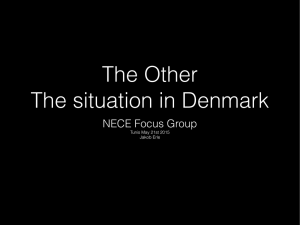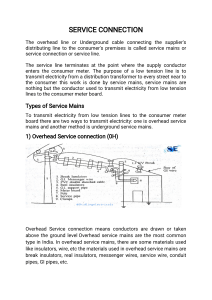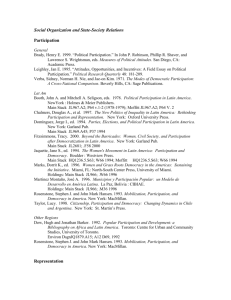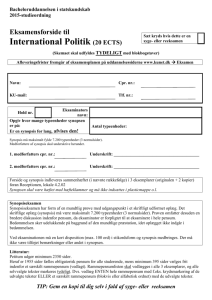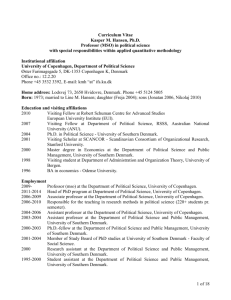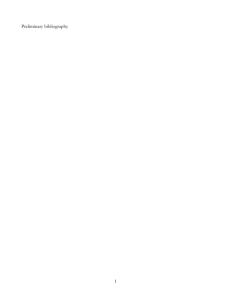Asbjørn Skjæveland - Studerende
advertisement
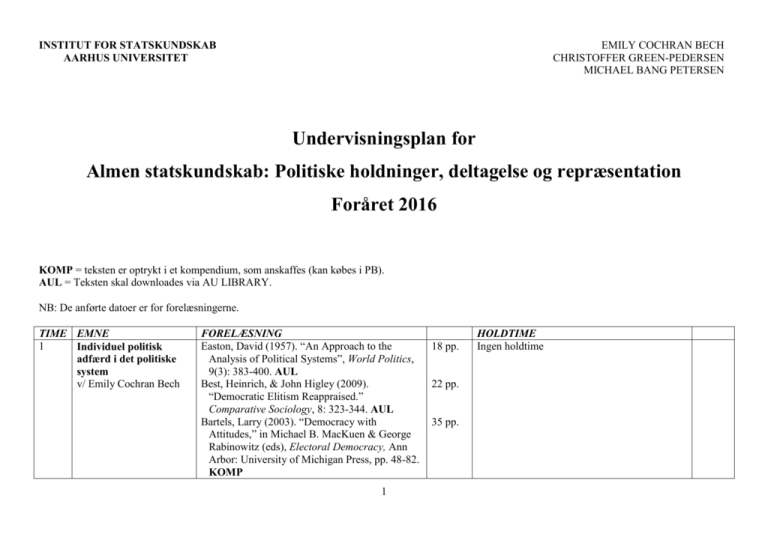
INSTITUT FOR STATSKUNDSKAB AARHUS UNIVERSITET EMILY COCHRAN BECH CHRISTOFFER GREEN-PEDERSEN MICHAEL BANG PETERSEN Undervisningsplan for Almen statskundskab: Politiske holdninger, deltagelse og repræsentation Foråret 2016 KOMP = teksten er optrykt i et kompendium, som anskaffes (kan købes i PB). AUL = Teksten skal downloades via AU LIBRARY. NB: De anførte datoer er for forelæsningerne. TIME EMNE 1 Individuel politisk adfærd i det politiske system v/ Emily Cochran Bech FORELÆSNING Easton, David (1957). “An Approach to the Analysis of Political Systems”, World Politics, 9(3): 383-400. AUL Best, Heinrich, & John Higley (2009). “Democratic Elitism Reappraised.” Comparative Sociology, 8: 323-344. AUL Bartels, Larry (2003). “Democracy with Attitudes,” in Michael B. MacKuen & George Rabinowitz (eds), Electoral Democracy, Ann Arbor: University of Michigan Press, pp. 48-82. KOMP 1 18 pp. 22 pp. 35 pp. HOLDTIME Ingen holdtime 2 3 4 Social position og politisk ideologi v/ Emily Cochran Bech Social og politisk identitet v/ Emily Cochran Bech Politiske skillelinjer v/ Emily Cochran Bech Svallfors, Stefan (2007). “Class and Attitudes to Market Inequality: A Comparison of Sweden, Britain, Germany, and the United States,” in Stefan Svalfors (red.), The Political Sociology of the Welfare State: Institutions, Social Cleavages, and Orientations, Stanford, CA: Stanford University Press, pp. 189-222. KOMP Inglehart, Ronald (2008). “Changing Values among Western Publics from 1970 to 2006.” West European Politics, 31(1): 130-146. AUL Ellemers, Naomi (2012). “The Group Self”, Science, 336: 848-852. AUL Campbell, Angus, Philip E. Converse, Warren E. Miller & Donald E. Stokes (1960). The American Voter, Chicago, IL: University of Chicago Press, pp. 120-124, 128-136. KOMP Gurin, Patricia, Arthur H. Miller & Gerald Gurin (1980). “Stratum Identification and Consciousness”, Social Psychology Quarterly, 43(1): 30-47. AUL Bornschier, Simon (2009). ”Cleavage Politics in Old and New Democracies”, Living Reviews in Democracy: 1-13. AUL Rokkan, Stein (1987). Stat, nasjon, klasse, Oslo: Universitetsforlaget AS, pp. 236, 239-264. KOMP 2 34 pp. Stubager, Rune & Jørgen Goul Andersen (2013). ”Godernes omfordeling: baggrunden for vælgernes holdninger til skat og ulighed,” i R. Stubager et al. (red.), Krisevalg. Økonomien og folketingsvalget 2011. København: Jurist- og økonomforbundets Forlag, pp. 89-108. KOMP 20 pp. Sniderman, Paul & Louk Hagendoorn (2007). When Ways of Life Collide. Princeton: Princeton University Press, pp. 71-99 (kap. 4: “Identity”). KOMP 29 pp. Stubager, Rune (2013). “The Changing Basis of Party Competition: Education, Authoritarian–Libertarian Values and Voting”, Government & Opposition, 48(3): 372-397. AUL 26 pp. 17 pp. 5 pp. 14 pp. 18 pp. 13 pp. 27 pp. 5 6 7 Togeby, Lise (2004). Man har et standpunkt… Politisk Om stabilitet og forandring i befolkningens holdningsdannelse: holdninger, Århus: Aarhus Universitetsforlag. Information og Kapitel 2: “At undersøge holdningsændringer” heuristikker v/ Michael Bang Petersen (pp. 20-34) + Kapitel 16: “Holdningernes kvalitet” (pp. 245-259). KOMP Sniderman, Paul M., Richard A. Brody & Philip E. Tetlock (1991). Reasoning and Choice: Explorations in Political Psychology, New York: Cambridge University Press, pp. 14-27 + p. 273. KOMP Jost, John T., Brian A. Nosek & Samuel D. Politiske Gosling (2008). “Ideology: Its resurgence in prædispositioner v/ Michael Bang Petersen social, personality, and political psychology”, Perspectives on Psychological Science, 3(2): 126-136. AUL Petersen, Michael Bang & Lene Aarøe (2014). ”Politisk psykologi: De næste skridt”, Politik, 17(3): 38-48. KOMP Kinder, Donald R. (2003). “Communication and Effekter af politisk Politics in the Age of Information”, i David O. kommunikation v/ Michael Bang Petersen Sears, Leonie Huddy & Robert Jervis (eds), Oxford Handbook of Political Psychology, Oxford: Oxford University Press, pp. 357-393. KOMP Sniderman, Paul M. & Sean M. Theriault (2004). “The Structure of Political Argument and the Logic of Issue Framing”, pp. 133-165 i Willem E. Saris & Paul M. Sniderman (eds), Studies in Public Opinion, Princeton, NJ: Princeton University Press. KOMP 3 30 pp. Petersen, Michael Bang, Rune, Slothuus, Rune Stubager & Lise Togeby (2011). ”Deservingness versus values in public opinion on welfare: The automaticity of the deservingness heuristic”, European Journal of Political Research, 50(1): 24-52. AUL 29 pp. Nørgaard, Asbjørn S., Robert Klemmensen, Peter Thisted Dinesen & A. Skytthe (2012). ”Kun i mørket er alle katte grå: Betydningen af genetik og individuelle forskelle for politisk adfærd”, Politica, 44(4): 469-487. KOMP 19 pp. Arceneaux, Kevin (2012). “Cognitive biases and the strength of political arguments”, American Journal of Political Science, 56(2): 271-285. AUL 15 p. 15 pp. 11 pp. 21 pp. 37 pp. 33 pp. 8 9 10 Bartels, Larry (2010). “The Study of Electoral Vælgeradfærd v/ Michael Bang Petersen Behavior”, i Jan E. Leighley (ed.), The Oxford Handbook of American Elections and Political Behavior, Oxford: Oxford University Press, pp. 239-261. KOMP Downs, Anthony (1957). An Economic Theory of Democracy, New York NY: Harper and Row, pp. 36-50. KOMP Basinger, Scott J. & Howard Lavine (2005). Vælgermobilisering v/ Michael Bang Petersen “Ambivalence, Information, and Electoral Choice”, American Political Science Review, 99(2): 169-184. AUL Taber, Charles S. & Milton Lodge (2006). “Motivated Skepticism in the Evaluation of Political Beliefs”, American Journal of Political Science, 50(3): 755-769. AUL Green-Pedersen, Christoffer (2007). ”The Partier: Growing Importance of Issue Competition: The Samfundsforandring, Changing Nature of Party Competition in partisystemer og Western Europe”, Political Studies, 55(3): 607partikonkurrence v/ Christoffer Green628. AUL Pedersen Hanspeter Kriesi et al. (2006). “Globalization and the transformation of the national political space: Six European countries compared”, European Journal of Political Research, 45(6): 921-956. AUL 4 23 pp. Clarke, Sanders, Stewart & Whiteley (2009). Performance Politics and the British Voter, Cambridge: Cambridge University Press, pp. 143-174 + 339-342. KOMP 36 pp. Gallego, Aina, & Daniel Oberski (2012). “Personality and Political Participation: The Mediation Hypothesis”, Political Behavior, 34(3): 425-451. AUL 27 pp. Jensen, Carsten & Jens Peter Frølund Thomsen (2013). ”Can party competition amplify mass ideological polarization over public policy? The case of ethnic exclusionism in Denmark and Sweden”, Party Politics, 19: 821-840. AUL 20 pp. 15 pp. 16 pp. 15 pp. 22 pp. 36 pp. 11 12 13 14 Katz, Richard & Peter Mair (1995). “Changing Models of Party Organization and Party Democracy. The Emergence of the Cartel Party”, Party Politics, 1(1): 5-28. AUL Scarrow, Susan E. & Burcu Gezgor (2010). “Declining memberships, changing members? European political party members in a new era”, Party Politics, 16(6): 823-843. AUL Medierne: udvikling og Hjarvard, S. (2008). En verden af medier. Medialiseringen af politik, sprog, religion og funktionsmåde v/ Christoffer Greenleg, København: Samfundslitteratur: 63-104. Pedersen KOMP Allern, S. & M. Blach-Ørsten (2011). “The News Media as a Political Institution: A Scandinavian Perspective”, Journalism Studies, 12(1): 92105. AUL Bennett, W.L. (1990). “Toward a theory of pressMedierne: samspilet state relations in the United States”, Journal of mellem medier, partier Communication, 40(2): 103-125. AUL og befolkning v/ Christoffer GreenWalgrave, S. & P.V. Aelst (2006). ”The Pedersen Contingency of the Mass Media’s Political Agenda Setting Power: Toward a Preliminary Theory”, Journal of Communication, 56(1): 88109. AUL Interesseorganisationer: Olson, Mancur (1971). The Logic of Collective Action. Public Goods and the Theory of Groups. deltagelse og Cambridge, MA: Harvard University Press. Pp. mobilisering v/ Emily Cochran Bech 1-36. KOMP Putnam, Robert (1995). “Bowling Alone: America’s Declining Social Capital”, Journal of Democracy, 6(1): 65-78. AUL Partier: Mobilisering or og organisering v/ Christoffer GreenPedersen 5 24 pp. 21 pp. 42 pp. Pedersen, Helene Helboe (2012). “Differences and Changes in Danish Party Organisations: Central Party Organisation versus Parliamentary Party Group Power.” Journal of Legislative Studies, 16(2): 2010, 233-250. AUL 18 pp. Pedersen, Rasmus Tue (2012): “The game frame and political efficacy: Beyond the spiral of cynicism”, European Journal of Communication, 27(3): 225-240. AUL 16 pp. Thesen, Gunnar (2014). “Political AgendaSetting as Mediatized Politics? MediaPolitics Interactions from a Party and Issue Competition Perspective”, The International Journal of Press/Politics, 19(2): 181-201. AUL 21 pp. Fisker, Helene M. (2013). “Density Dependence in Corporative Systems: Development of the Population of Danish Patient Groups, 1901-2011”. Interest Groups and Advocacy, 2(2): 119-138. AUL 20 pp. 14 pp. 23 pp. 22 pp. 37 pp. 14 pp. 15 Interesseorganisationer: Schlozman, Kay (2012). ”Counting the Voices in the Heavenly Chorus: Pressure Participants in input til det politiske Washington Politics in Darren Halpin & Grant system v/ Christoffer GreenJordan (eds), The Scale of Interest Organization Pedersen in Democratic Politics. Data and Research Methods. Palgrave MacMillan, pp. 23-43. KOMP Binderkrantz, Anne (2005). ”Interest Group Strategies: Navigating Between Privileged Access and Strategies of Pressure”, Political Studies, 53(4): 694-715. AUL 21 pp. Mahoney, Christine (2004). “The Power of Institutions: State and Interest Group Activity in the European Union”, European Union Politics, 5(4): 441-466. AUL 22 pp. Holdtime: Diskussion af skriveøvelse og eksamen SAMLET PENSUM: 1012 sider 6 26 pp.
